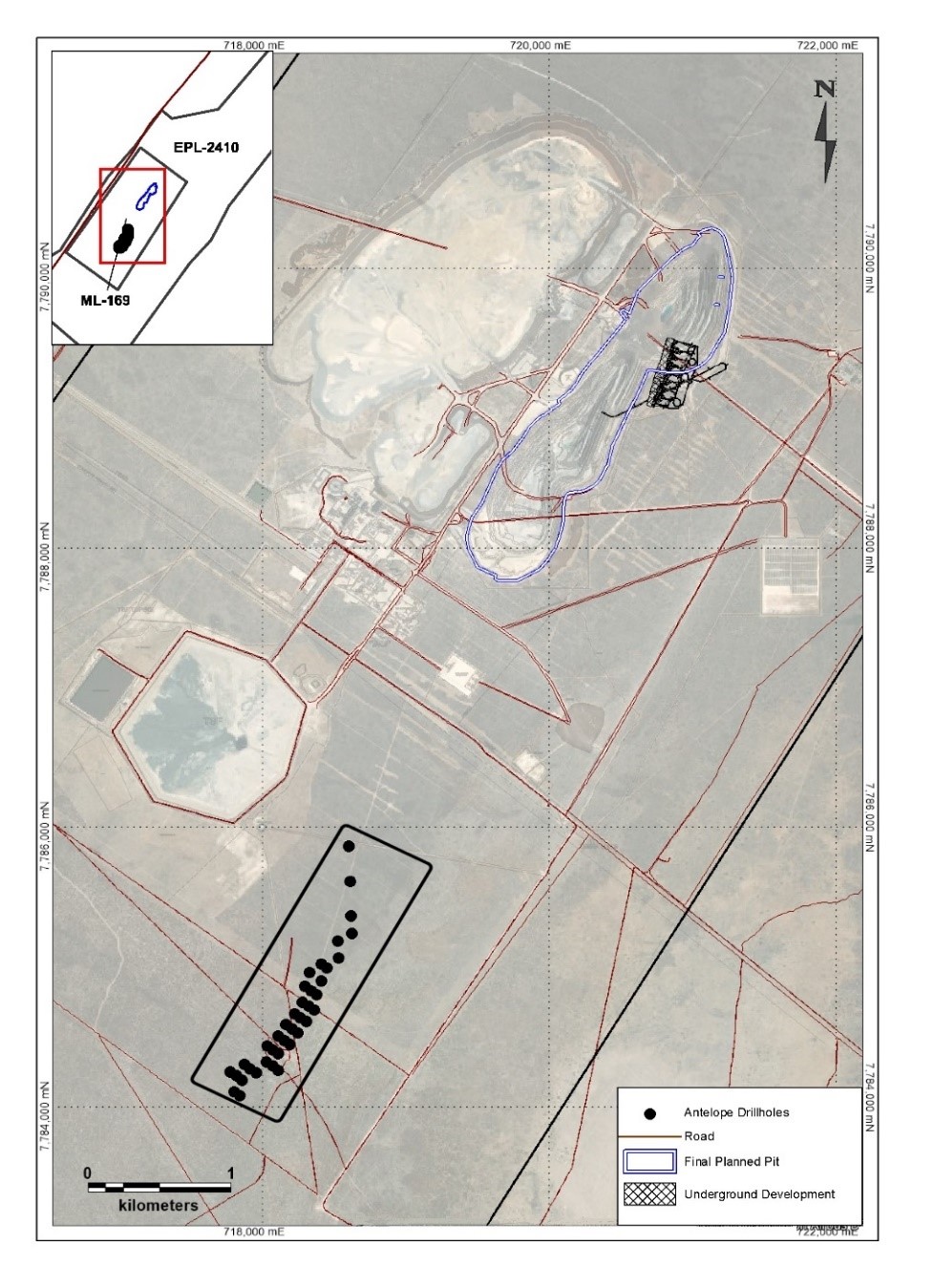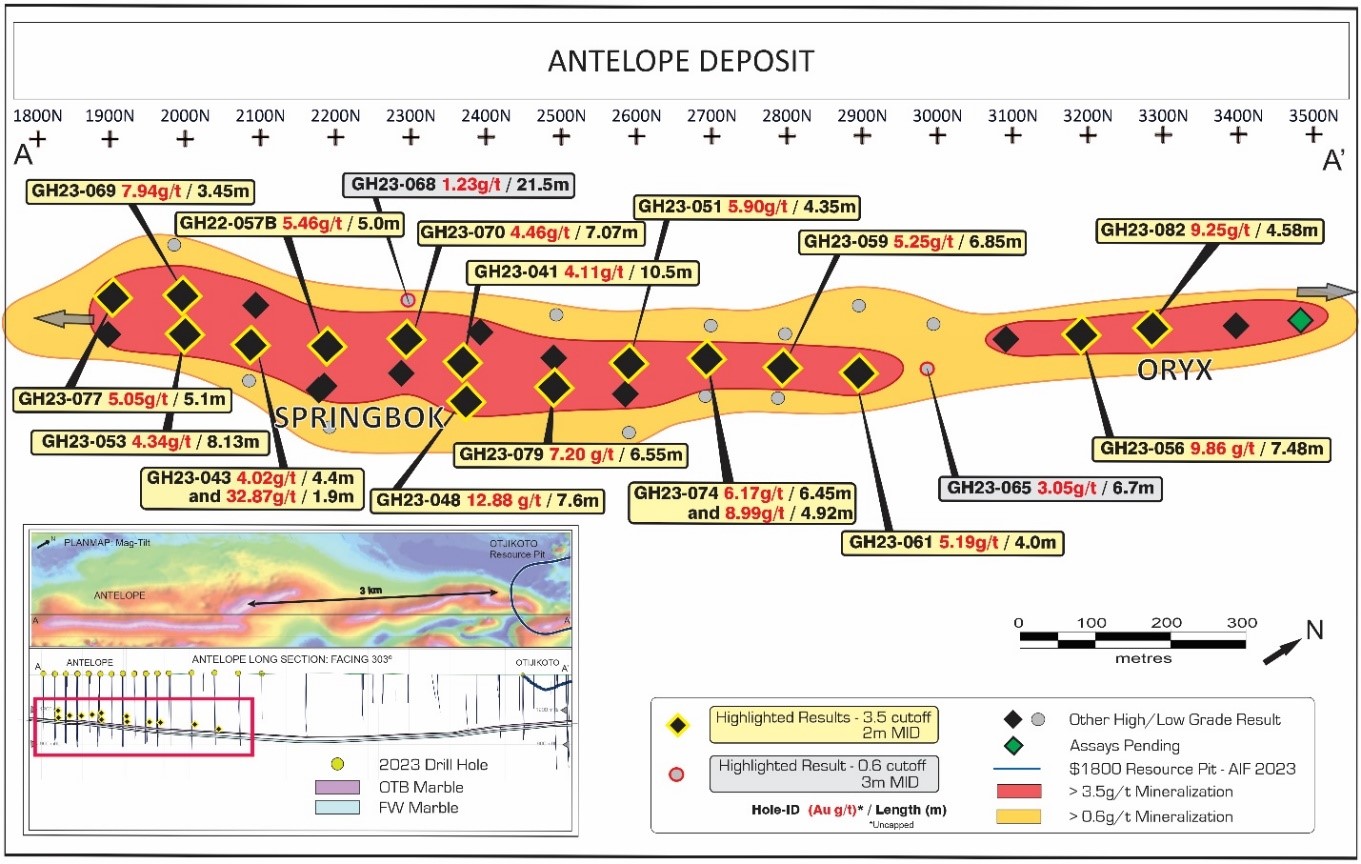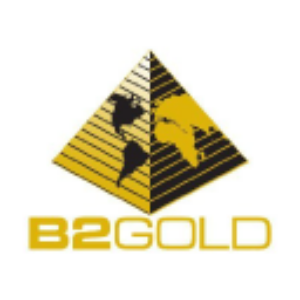B2Gold Announces Positive Exploration Drilling Results from the Antelope Deposit at the Otjikoto Mine in Namibia, Highlighting the Potential to Expand Underground Gold Production through the Early 2030’s
VANCOUVER, British Columbia, Jan. 31, 2024 (GLOBE NEWSWIRE) -- B2Gold Corp. (TSX: BTO, NYSE AMERICAN: BTG, NSX: B2G) (“B2Gold” or the “Company”) is pleased to announce positive exploration drilling results from the Antelope deposit at the Otjikoto Mine (“Otjikoto”) in Namibia. The Antelope deposit, comprised of the Springbok Zone, the Oryx Zone, and a possible third structure, Impala, subject to further confirmatory drilling, is located approximately three kilometers (“km”) south of the Otjikoto Phase 5 open pit. The Antelope deposit has the potential to be developed as an underground mining operation, which could complement the expected processing of stockpiles at the Otjikoto mill from 2026 through 2031.
Highlights
- 20,715 meters (“m”) in 37 drill holes completed at the Antelope deposit in 2023, with a plan to nearly double the meters drilled in 2024
- The Antelope deposit was discovered in 2022 following deep drill testing on three-dimensional models of magnetic inversion data;
- The 2024 exploration budget for Otjikoto is US
$9 million , focused predominantly on the Antelope deposit, the largest drill program since the definition of the Wolfshag discovery in 2012; and - 39,000 m of drilling planned to define and expand the Antelope deposit.
- High-grade, Otjikoto-style mineralization discovered approximately 3 km south of the Phase 5 open pit at Otjikoto; in several structures referred to as the Antelope deposit
- Drill hole GH22-048 intersected 12.88 grams per tonne (“g/t”) gold over 7.60 m from 485.00 m at the Springbok Zone;
- Drill hole GH23-056 intersected 9.86 g/t gold over 7.48 m from 517.55 m at the Oryx Zone; and
- The Company believes this style of mineralization could be amenable to underground mining methods similar to those used at the Wolfshag underground mine.
- Drill results at the Springbok Zone and Oryx Zone indicate the potential for possible underground development of the Antelope deposit, which could begin to contribute to gold production at Otjikoto in 2026
- Open pit operations at Otjikoto are anticipated to conclude in 2025, while underground mining operations at Wolfshag will continue through 2026;
- Current gold production estimates at Otjikoto are expected to be between 180,000 to 200,000 ounces in 2024 and 2025, just under 100,000 ounces in 2026, and stepping down to sub 50,000 ounces from 2026 through 2031 during the processing of low-grade stockpiles;
- Underground mining of the Antelope deposit has the potential to supplement the processing of stockpiles through 2031, with the goal of increasing gold production levels to over 100,000 ounces per year from 2026 through 2031; and
- An initial Mineral Resource estimate at the Antelope deposit is anticipated by the third quarter of 2024, with an internal scoping study on an underground mining operation to be completed by the first quarter of 2025.
Figure 1. Antelope Deposit Location Overview.

2023 Otjikoto Exploration Program
In 2023, B2Gold completed a US
The Antelope deposit was discovered in 2022, following deep drill testing on three-dimensional models of magnetic inversion data. The Antelope deposit is comprised of up to three separate mineralized structures, of which the southernmost Springbok Zone has been defined by 100 m by 50 m spaced drilling, over a strike length of approximately 800 m. Mineralization has a dip extent of approximately 150 m and is between 7 m to 10 m thick.
Northeast, along strike of the Springbok Zone, a similar type of high-grade mineralization has been intersected in the Oryx Zone, which appears to represent a second shoot, stacked stratigraphically above the Springbok Zone. Overall, the Antelope deposit mineralization has been intersected by drilling over a combined strike length of approximately 1,500 m. As the significant mineralization is intersected from approximately 450 m down hole, the Antelope deposit is being evaluated for potential underground development.
Significant 2023 drill results from the Antelope deposit include:
| HoleID | Zone | From (m) | To (m) | Length (m) | Au (g/t) |
| GH22-041 | Springbok | 465.30 | 475.80 | 10.50 | 4.11 |
| GH22-042 | Springbok | 456.90 | 461.00 | 4.10 | 5.49 |
| GH22-043 | Springbok | 436.60 | 441.00 | 4.40 | 4.02 |
| and | Springbok | 444.00 | 445.90 | 1.90 | 32.87 |
| GH22-047 | Springbok | 430.00 | 434.90 | 4.90 | 6.80 |
| and | Springbok | 439.20 | 442.45 | 3.25 | 8.89 |
| GH22-048 | Springbok | 485.00 | 492.60 | 7.60 | 12.88 |
| GH23-050 | Springbok | 465.05 | 470.70 | 5.65 | 5.79 |
| GH23-051 | Springbok | 494.65 | 499.00 | 4.35 | 5.90 |
| GH23-053 | Springbok | 429.17 | 437.30 | 8.13 | 4.34 |
| GH23-055 | Springbok | 503.19 | 511.74 | 8.55 | 5.73 |
| GH23-057B | Springbok | 445.10 | 450.10 | 5.00 | 5.46 |
| GH23-059 | Springbok | 487.15 | 494.00 | 6.85 | 5.25 |
| GH23-061 | Springbok | 489.00 | 493.00 | 4.00 | 5.19 |
| GH23-069 | Springbok | 431.70 | 435.15 | 3.45 | 7.94 |
| GH23-070 | Springbok | 460.48 | 467.55 | 7.07 | 4.46 |
| GH23-073 | Springbok | 467.90 | 471.50 | 3.60 | 16.70 |
| GH23-074 | Springbok | 493.00 | 499.45 | 6.45 | 6.17 |
| and | Springbok | 506.62 | 511.54 | 4.92 | 8.99 |
| GH23-076 | Springbok | 489.85 | 491.63 | 1.78 | 3.77 |
| GH23-077 | Springbok | 423.70 | 428.80 | 5.10 | 5.05 |
| GH23-079 | Springbok | 495.25 | 501.80 | 6.55 | 7.20 |
| GH23-080 | Springbok | 424.65 | 426.65 | 2.00 | 23.34 |
| GH23-056 | Oryx | 517.55 | 525.03 | 7.48 | 9.86 |
| GH23-060 | Oryx | 534.95 | 541.55 | 6.60 | 3.22 |
| GH23-081 | Oryx | 524.66 | 527.66 | 3.00 | 6.54 |
| GH23-082 | Oryx | 536.87 | 541.45 | 4.58 | 9.25 |
Notes: All composites above 3.5 g/t gold cutoff, applying a maximum internal dilution of 2.00 m. Results are uncapped. Core lengths approximate true width of mineralized intervals.
Mineralization of the Antelope deposit is characterized by quartz-pyrrhotite veins, which have been overprinted by deformation focused along two main marble beds that serve as major stratigraphic markers in the Otjikoto stratigraphy. The shoot-like geometry of the Antelope deposit mineralization derives, in part, from the thickening of quartz-pyrrhotite-gold mineralization in the hinge zones of centimeter-to meter-scale folds, a structural control that is well documented at Otjikoto. Mineralized shoots plunge shallowly north-northeast, suggesting a subtle inflection in the stratigraphy that hosts Otjikoto, where mineralized zones plunge shallowly south-southwest. Mineralization in each of the respective shoots remains open along the plunge direction.
The mineralized zones are associated with a positive magnetic response that extends southward from the Otjikoto open pit as a continuous linear feature for over 4 km. Testing the continuity of this magnetic feature and its possible connection with the southernmost extent of ore in the Phase 5 open pit at Otjikoto will be a significant part of the 2024 exploration program.
2024 Exploration Program and Development Assessment
The exploration budget for Namibia in 2024 is US
Open pit mining operations at Otjikoto are scheduled to ramp down throughout 2024 and conclude in 2025, while underground mining operations at Wolfshag are expected to continue through 2026. Processing operations will continue through 2031, when economically viable stockpiles are forecast to be exhausted. These positive drill results from the Antelope deposit indicate there is potential for a possible underground development to supplement the processing of stockpiles through 2031, with the goal of increasing Otjikoto gold production levels to over 100,000 ounces per year from 2026 through 2031.
Figure 2. Plan view of Antelope deposit drilling. HG mineralization contour >3.5 g/t and LG mineralization contour >0.6 g/t gold.

Quality Assurance/Quality Control on Sample Collection and Assaying
LeachWell analysis at the Otjikoto Mine Lab has been the primary method of analysis of samples from the Antelope deposit. Assay composites presented herein are derived from 1-kilogram samples. In-house studies by B2Gold indicate that LeachWell results compare favourably to fire assay completed by ALS Johannesburg, on the first four drill holes of the Antelope deposit drilling program.
Quality assurance and quality control procedures include the systematic insertion of blanks, standards and duplicates in the drill core sample sequence. The results of the control samples are evaluated on a regular basis with partial batches re-analyzed and/or resubmitted on exploration samples, as needed. All results stated in this announcement have been accepted according to B2Gold’s quality assurance and quality control protocols.
About B2Gold
B2Gold is a low-cost international senior gold producer headquartered in Vancouver, Canada. Founded in 2007, today, B2Gold has operating gold mines in Mali, Namibia and the Philippines, a mine under construction in northern Canada and numerous development and exploration projects in various countries including Mali, Colombia and Finland.
Qualified Persons
Andrew Brown, P. Geo., Vice President, Exploration, a qualified person under NI 43-101, has approved the scientific and technical information related to exploration and mineral resource matters contained in this news release.
ON BEHALF OF B2GOLD CORP.
“Clive T. Johnson”
President and Chief Executive Officer
The Toronto Stock Exchange and NYSE American LLC neither approve nor disapprove the information contained in this news release.
Production results and production guidance presented in this news release reflect total production at the mines B2Gold operates on a
This news release includes certain "forward-looking information" and "forward-looking statements" (collectively forward-looking statements") within the meaning of applicable Canadian and United States securities legislation, including: projections; outlook; guidance; forecasts; estimates; and other statements regarding future or estimated financial and operational performance, gold production and sales, revenues and cash flows, and capital costs (sustaining and non-sustaining) and operating costs, including projected cash operating costs and AISC, and budgets on a consolidated and mine by mine basis, which if they occur, would have on our business, our planned capital and exploration expenditures; future or estimated mine life, metal price assumptions, ore grades or sources, gold recovery rates, stripping ratios, throughput, ore processing; statements regarding anticipated exploration, drilling, development, construction, permitting and other activities or achievements of B2Gold; and including, without limitation: the potential for the Antelope deposit to be developed as an underground operation and contribute gold during the low-grade stockpile processing in 2026. All statements in this news release that address events or developments that we expect to occur in the future are forward-looking statements. Forward-looking statements are statements that are not historical facts and are generally, although not always, identified by words such as "expect", "plan", "anticipate", "project", "target", "potential", "schedule", "forecast", "budget", "estimate", "intend" or "believe" and similar expressions or their negative connotations, or that events or conditions "will", "would", "may", "could", "should" or "might" occur. All such forward-looking statements are based on the opinions and estimates of management as of the date such statements are made.
Forward-looking statements necessarily involve assumptions, risks and uncertainties, certain of which are beyond B2Gold's control, including risks associated with or related to: the volatility of metal prices and B2Gold's common shares; changes in tax laws; the dangers inherent in exploration, development and mining activities; the uncertainty of reserve and resource estimates; not achieving production, cost or other estimates; actual production, development plans and costs differing materially from the estimates in B2Gold's feasibility and other studies; the ability to obtain and maintain any necessary permits, consents or authorizations required for mining activities; environmental regulations or hazards and compliance with complex regulations associated with mining activities; climate change and climate change regulations; the ability to replace mineral reserves and identify acquisition opportunities; the unknown liabilities of companies acquired by B2Gold; the ability to successfully integrate new acquisitions; fluctuations in exchange rates; the availability of financing; financing and debt activities, including potential restrictions imposed on B2Gold's operations as a result thereof and the ability to generate sufficient cash flows; operations in foreign and developing countries and the compliance with foreign laws, including those associated with operations in Mali, Namibia, the Philippines and Colombia and including risks related to changes in foreign laws and changing policies related to mining and local ownership requirements or resource nationalization generally; remote operations and the availability of adequate infrastructure; fluctuations in price and availability of energy and other inputs necessary for mining operations; shortages or cost increases in necessary equipment, supplies and labour; regulatory, political and country risks, including local instability or acts of terrorism and the effects thereof; the reliance upon contractors, third parties and joint venture partners; the lack of sole decision-making authority related to Filminera Resources Corporation, which owns the Masbate Project; challenges to title or surface rights; the dependence on key personnel and the ability to attract and retain skilled personnel; the risk of an uninsurable or uninsured loss; adverse climate and weather conditions; litigation risk; competition with other mining companies; community support for B2Gold's operations, including risks related to strikes and the halting of such operations from time to time; conflicts with small scale miners; failures of information systems or information security threats; the ability to maintain adequate internal controls over financial reporting as required by law, including Section 404 of the Sarbanes-Oxley Act; compliance with anti-corruption laws, and sanctions or other similar measures; social media and B2Gold's reputation; risks affecting Calibre having an impact on the value of the Company's investment in Calibre, and potential dilution of our equity interest in Calibre; as well as other factors identified and as described in more detail under the heading "Risk Factors" in B2Gold's most recent Annual Information Form, B2Gold's current Form 40-F Annual Report and B2Gold's other filings with Canadian securities regulators and the U.S. Securities and Exchange Commission (the "SEC"), which may be viewed at www.sedar.com and www.sec.gov, respectively (the "Websites"). The list is not exhaustive of the factors that may affect B2Gold's forward-looking statements.
B2Gold's forward-looking statements are based on the applicable assumptions and factors management considers reasonable as of the date hereof, based on the information available to management at such time. These assumptions and factors include, but are not limited to, assumptions and factors related to B2Gold's ability to carry on current and future operations, including: development and exploration activities; the timing, extent, duration and economic viability of such operations, including any mineral resources or reserves identified thereby; the accuracy and reliability of estimates, projections, forecasts, studies and assessments; B2Gold's ability to meet or achieve estimates, projections and forecasts; the availability and cost of inputs; the price and market for outputs, including gold; foreign exchange rates; taxation levels; the timely receipt of necessary approvals or permits; the ability to meet current and future obligations; the ability to obtain timely financing on reasonable terms when required; the current and future social, economic and political conditions; and other assumptions and factors generally associated with the mining industry.
B2Gold's forward-looking statements are based on the opinions and estimates of management and reflect their current expectations regarding future events and operating performance and speak only as of the date hereof. B2Gold does not assume any obligation to update forward-looking statements if circumstances or management's beliefs, expectations or opinions should change other than as required by applicable law. There can be no assurance that forward-looking statements will prove to be accurate, and actual results, performance or achievements could differ materially from those expressed in, or implied by, these forward-looking statements. Accordingly, no assurance can be given that any events anticipated by the forward-looking statements will transpire or occur, or if any of them do, what benefits or liabilities B2Gold will derive therefrom. For the reasons set forth above, undue reliance should not be placed on forward-looking statements.
Figures accompanying this announcement are available at
https://www.globenewswire.com/NewsRoom/AttachmentNg/a61ddf83-a8a2-4979-9791-c6948cbc936d
https://www.globenewswire.com/NewsRoom/AttachmentNg/c86585e1-7537-4413-83ae-3eb51f988cfd








